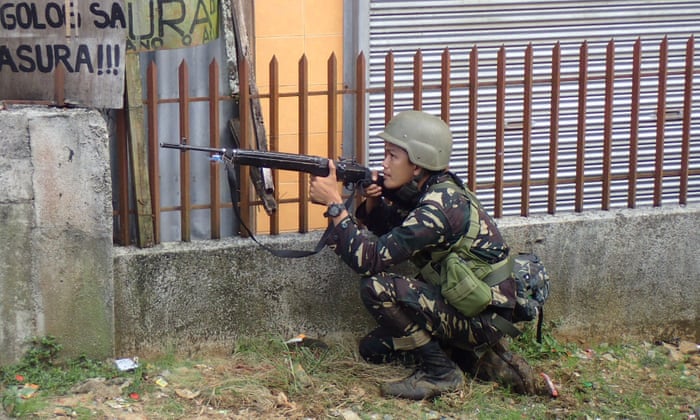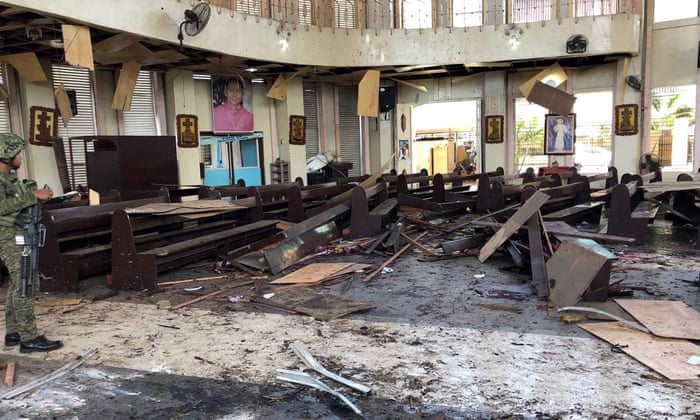Islamic State's Promising New Foothold
"ISIS has money coming into the Philippines, and they are recruiting fighters."
"ISIS is the most complicated, evolving problem for the Philippines today, and we should not pretend that it doesn't exist."
Rommel Baniaoi, chairman, Philippine Institute for Peace,Violence and Terrorism Research
"They convinced me [at age 11] that if you die in battle, you will be rewarded in the hereafter."
"They said it was the right path."
Jem Habing, 22, former Abu Sayyaf fighter
 |
| "The fight is not over"... The comment came just over a year after Isis was defeated in Marawi City, after a five-month battle with government forces (pictured). Photograph: Pacific P/REX/Shutterstock |
The Islamic State laid its claim to a pair of its suicide bombers causing the carnage during a January Sunday Mass at a Catholic cathedral in the Philippines when two bombs tore through the church compound, killing 23 people. To push home their point, Islamic State circulated on its dedicated chat groups an illustration of President Rodrigo Duterte kneeling on a pile of skulls with a terrorist over him holding a dagger, captioned "The fighting has just begun".
No longer does the Islamic State caliphate celebrate its existence in Iraq and Syria after four years of U.S.-backed bombs and Kurdish and Shiite militia fighters engaged in ground combat, finally extirpating the terrorist group from a territory once the size of Great Britain, taking up a third each of both Iraq and Syria, and planning even greater expansion before Russia entered the scene bombing while Syrian and Hezbollah troops and Iran-linked Shiite militias added to the toll taken on ISIS in Syria.
ISIS lost their precious caliphate territory but their ideological ferocity lives on in Africa and Asia. In the Mindanao island group of southern Philippines, a longtime haven for Islamist insurgents in a mostly Catholic nation, where dense wilderness and lax policing allows them to thrive, ISIL has gained dedicated converts. "ISIS has a lot of power", former child fighter Motondan Indama confirmed. "I don't know why my cousin joined, but it's happening all over."
 |
| Philippines’ soldiers clear streets in the battle for Marawi in 2017. Local authorities are monitoring Isis foreign fighters, with fears their numbers may have grown. Photograph: Jes Aznar/Getty Images |
In 2015, ISIS made its initial foray into southern Philippines, to recruit by circulating online videos leading to hundreds of fighters from disparate Islamist groups to pour in from Chechnya, Somalia and Yemen, according to intelligence officials. Militants pledging allegiance to Islamic State took over Mindanao's city of Marawi, bringing the Philippines' military into five months of battle, leaving the largest Muslim-majority city in the country in ruins.
Among the 900 Islamists killed there were foreign fighters and the Islamic State's East Asia emir Isnilon Hapilon with them. Despite victory being declared, Islamic State loyalists have since regrouped. Ten thousand Philippine soldiers have been deployed in Jolo, site of the January 27 cathedral bombing, and airstrikes by the military have been carried out intensively. Police had declared the bombing of the cathedral case-solved, blaming it on Abu Sayyaf, a local Islamist group.
Abu Sayyaf and other local Islamists have for decades pursued a campaign of bombings and beheadings, thriving in the lawless wilderness interior and seas from Philippines to Malaysia and Indonesia. Global calls for jihad resounded in the Philippines in the 1990s when Filipinos left the battlefields in the Middle East.
A peace agreement was struck with the government and former Abu Sayyaf rebels, bringing autonomy to the Muslim south. During the ensuing ceremony, security concerns mandated the presence of Philippine soldiers vastly outnumbering the presence of former rebels.
 |
| Two bombs hit the church in Sulu in January. The first blast occurred inside the church as mass was being celebrated, and was followed by a second explosion in the parking lot as troops responded. Photograph: HANDOUT/AFP/Getty Images |
Labels: Conflict, Islamic State, Islamists, Philippines

<< Home